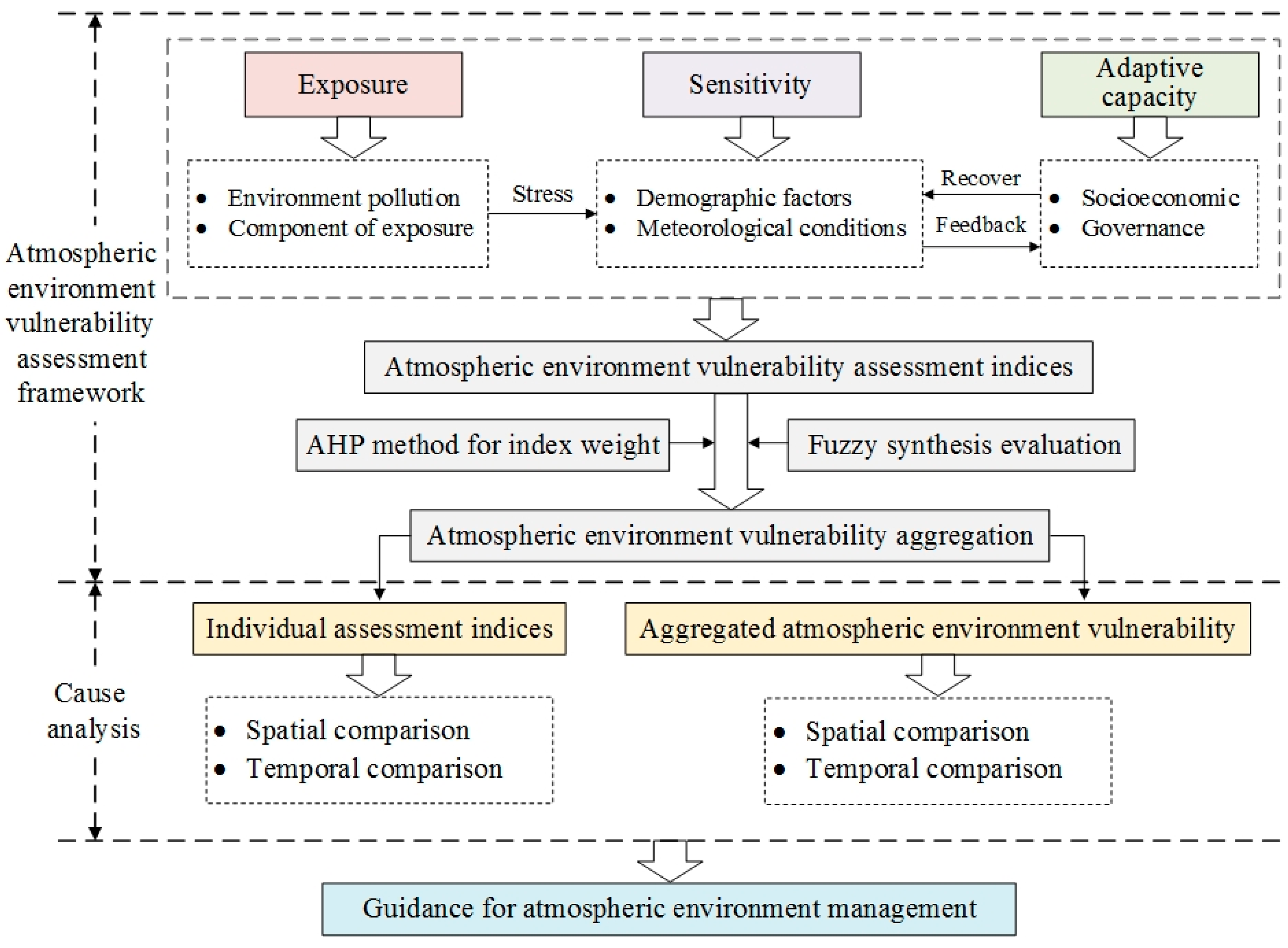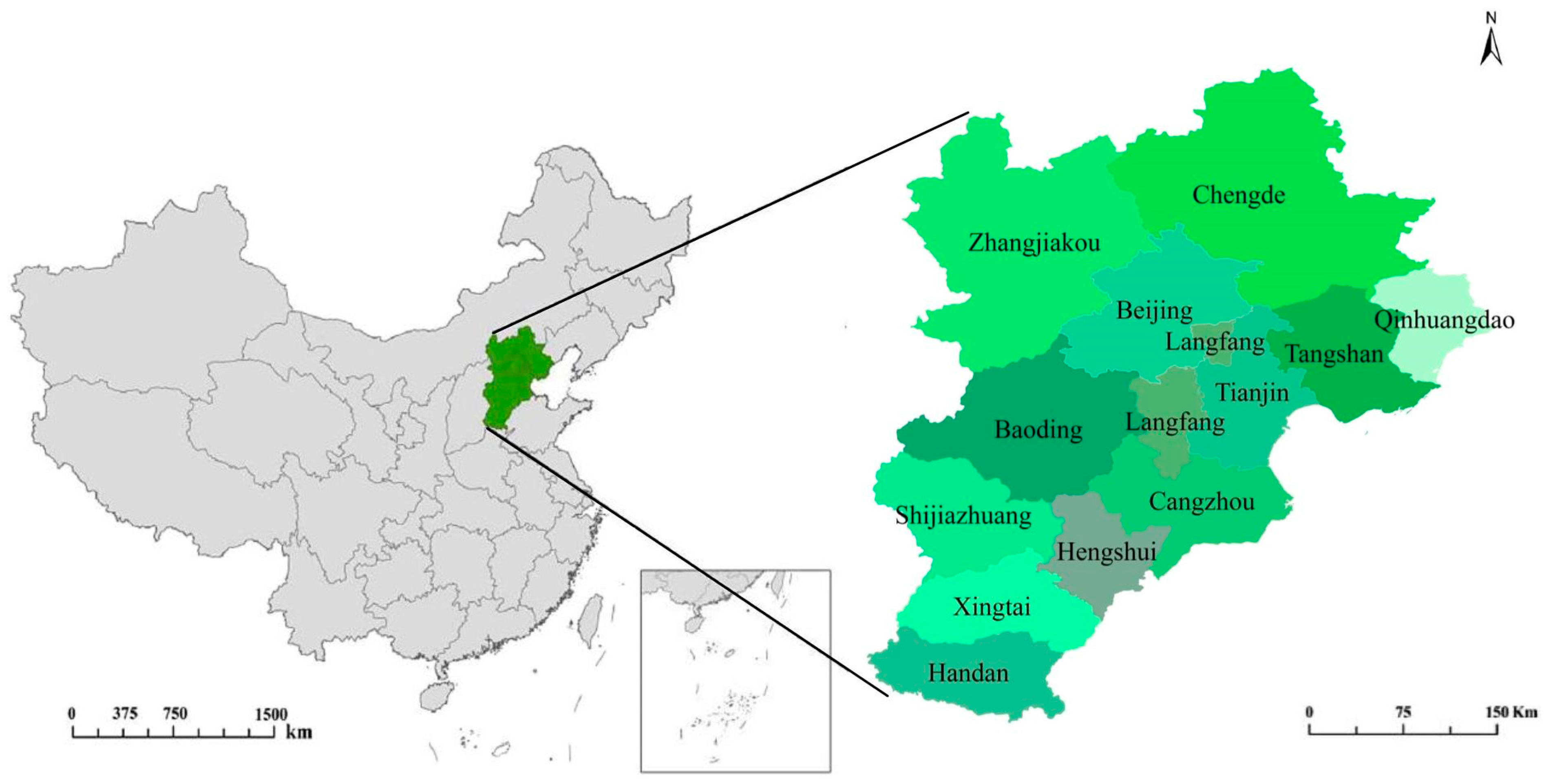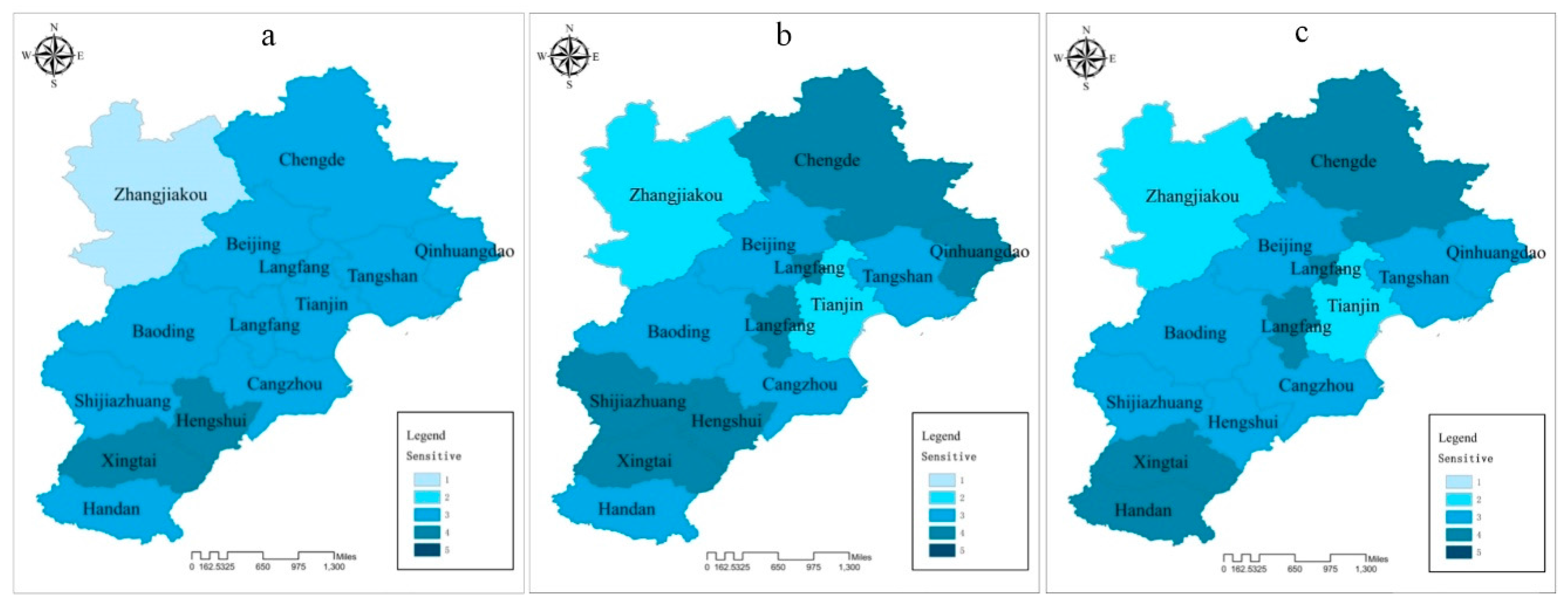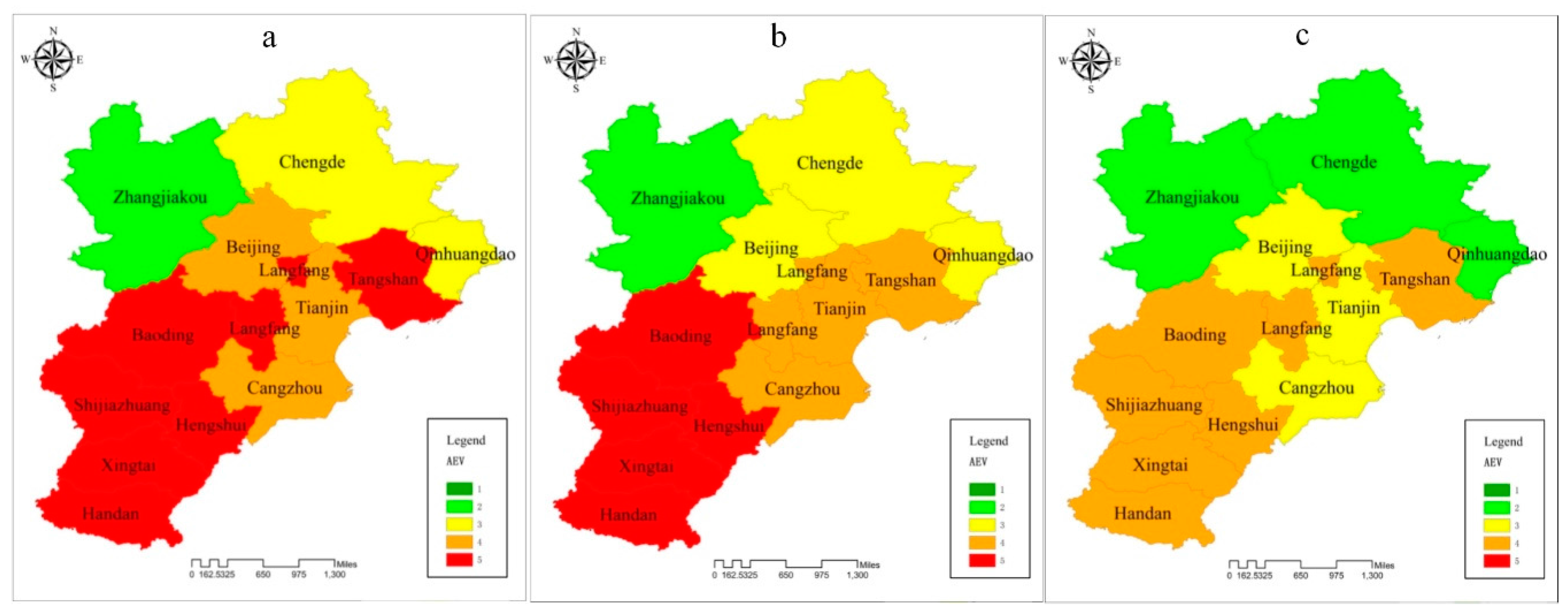Atmospheric Environment Vulnerability Cause Analysis for the Beijing-Tianjin-Hebei Metropolitan Region
Abstract
:1. Introduction
2. Methods
2.1. Atmospheric Environment Vulnerability Assessment Framework
2.2. AHP Method for Index Weights
- The objective of the interviews: determining the weights for the 15 indices in the atmospheric environment vulnerability assessment.
- The major questions include:
- (2.1)
- What is the contribution rank of exposure, sensitivity, and adaptive capacity for atmospheric environment vulnerability?
- (2.2)
- What is the contribution rank of “average annual concentration of PM2.5”, “average annual concentration of PM10”, “average annual concentration of SO2”, “average annual concentration of NO2”, “days of AQI equal to or better than grade II”, “days of AQI equal to and worse than grade V” for exposure?
- (2.3)
- What is the contribution rank of “population density”, “percentage of vulnerable groups”, “average annual rainfall”, “average annual wind speed”, “average annual relative humidity” for sensitivity?
- (2.4)
- What is the contribution rank of “proportion of secondary industry”, “motor vehicle population”, “coal consumption”, “percentage of urban greenery coverage” for adaptive capacity?
- (2.5)
- What is the total contribution rank of the 15 indices for atmospheric environment vulnerability?
2.3. Fuzzy Theory for Index Evaluation
2.4. Atmospheric Environment Vulnerability Aggregation
3. Case Study
3.1. Study Area
3.2. Data Resource
3.3. Results Description
3.3.1. Exposure
3.3.2. Sensitivity
3.3.3. Adaptive Capacity
3.3.4. Aggregated Atmospheric Environment Vulnerability
4. Discussion
- (1)
- Districts for general control. These districts consist of the regions with “potentially vulnerable” and “slightly vulnerable” vulnerability classes. These districts are mainly in the northern areas (Zhangjiakou, Chengde and Qinhuangdao), accounting for 38.75% of the area of the 13 cities in the BTH region.
- (2)
- Districts for key control. These districts are in the vulnerability class “moderately vulnerable”, lying mainly in the central cities (Beijing, Tianjin and Cangzhou), with 16.72% of the area of the 13 cities in the BTH region.
- (3)
- Districts for strict control. The cities with “significantly vulnerable” and “extremely vulnerable” vulnerability classes generate these districts, lying mainly in the southwestern (Baoding, Shijiazhuang, Hengshui, Xingtai, Langfang and Handan) and southeastern cities (Tangshan), accounting for 44.53% of the area of the 13 cities in the BTH region.
5. Conclusions
Supplementary Materials
Acknowledgments
Author Contributions
Conflicts of Interest
Appendix A. Weights Determination
- (1)
- Deconstruct the decision-making problem into a hierarchical structure with “atmospheric environment vulnerability” as decision objective, which is deconstructed into the second layer with exposure index, sensitivity index, and adaptive capacity index. Each group is further deconstructed into a third layer according to its own attributes.
- (2)
- Make decision tables for each layer of the hierarchical decomposition with pair-wise comparisons. A preference scaling approach is executed in the pair-wise comparisons with 17 scales numbers: 9, 8, 7…, 1/7, 1/8, 1/9 where 9 means the most important, 8 the second most important, and so on down to 1/9, the least important.
- (3)
- Make a judgement matrix with the scales numbers from step 2 to establish the relationships between attributes and group index, as shown in Table S1. In the judgement matrix, 1 are the values of diagonal. If the ith row is more important than the jth column, then the value of (i, j) is more than 1, otherwise the jth column is more important than the ith row. Meanwhile, the value of (j, i) in the matrix is the reciprocal of that in (i, j).
- (4)
- Determine the weights for each attribute and group index with the largest eigenvalue (λmax) of the judgement matrix as shown in Equation (A1):
- (5)
- Estimate the consistency of the judgement matrix by consistency ratio (CR). The CR is defined as the ratio between consistency index (CI) and random index (RI), as shown in Equation (A2):where the consistency index (CI) is the consistency of a given evaluation matrix and calculated by Equation (A3):and the RI is a random matrix defined as the average of resulting consistency index depending on the order of the matrix. The value of CR is suggested to be less than 0.1, which means that the judgement matrix has reasonable consistency. All the CR values of each matrix in our paper are lower than 0.10, which demonstrates the suitability of the calculated weights.
- (6)
- Aggregate the local weight of each parameter to achieve the weight of corresponding group index, as shown in Table 2.
Appendix B. Fuzzy Theory for Index Evaluation
- Step 1.1: Define atmospheric vulnerability indicators for each criterion under a sub-project.
- A list of criteria and indicators for the project of “atmospheric vulnerability” developed in this study is presented in Table 1.
- Step 1.2: Establish a common linguistic scale for developing benchmarks for each indicator.
- A five-level linguistic scale was used to develop benchmarks for all the indicators based on values provided in references and expert opinion.
- Step 1.3: Establish indicator values corresponding to each linguistic scale.
References
- Ippolito, A.; Sala, S.; Faber, J.H.; Vighi, M. Ecological vulnerability analysis: A river basin case study. Sci. Total Environ. 2010, 408, 3880–3890. [Google Scholar] [CrossRef] [PubMed]
- Jin, Q.; Fang, X.; Wen, B.; Shan, A. Spatio-temporal variations of PM2.5 emission in China from 2005 to 2014. Chemosphere 2017, 183, 429–436. [Google Scholar] [CrossRef] [PubMed]
- Zhao, S.; Yu, Y.; Qin, D.; Yin, D.; He, J. Assessment of long-term and large-scale even-odd license plate controlled plan effects on urban air quality and its implication. Atmos. Environ. 2017, 170, 82–95. [Google Scholar] [CrossRef]
- Ren, Y.; Qu, Z.; Du, Y.; Xua, R.; Ma, D.; Yang, G.; Shi, Y.; Fan, X.; Tani, A.; Guo, P.; Ge, Y. Air quality and health effects of biogenic volatile organic compounds emissions from urban green spaces and the mitigation strategies. Environ. Pollut. 2017, 230, 849–861. [Google Scholar] [CrossRef] [PubMed]
- Attard, G.; Rossier, Y.; Eisenlohr, L. Underground structures increasing the intrinsic vulnerability of urban groundwater: Sensitivity analysis and development of an empirical law based on a groundwater age modelling approach. J. Hydrol. 2017, 552, 460–473. [Google Scholar] [CrossRef]
- Klaas, D.K.; Imteaz, M.A.; Arulrajah, A. Development of groundwater vulnerability zones in a data-scarce eogenetic karst area using Head-Guided Zonation and particle-tracking simulation methods. Water Res. 2017, 122, 17–26. [Google Scholar] [CrossRef] [PubMed]
- Fawcett, D.; Pearce, T.; Ford, J.D.; Archer, L. Operationalizing longitudinal approaches to climate change vulnerability assessment. Glob. Environ. Chang. 2017, 45, 79–88. [Google Scholar] [CrossRef]
- El-Zein, A.; Tonmoy, F. Nonlinearity, fuzziness and incommensurability in indicator-based assessments of vulnerability to climate change: A new mathematical framework. Ecol. Indic. 2017, 82, 82–93. [Google Scholar] [CrossRef]
- Berrouet, L.M.; Machado, J.; Palacio, C.V. Vulnerability of socio—Ecological systems: A conceptual Framework. Ecol. Indic. 2018, 84, 632–647. [Google Scholar] [CrossRef]
- Hong, W.; Jiang, R.; Yang, C.; Zhang, F.; Su, M.; Liao, Q. Establishing an ecological vulnerability assessment indicator system for spatial recognition and management of ecologically vulnerable areas in highly urbanized regions: A case study of Shenzhen, China. Ecol. Indic. 2016, 69, 540–547. [Google Scholar] [CrossRef]
- Costa, J.M.; Vaz, M.; Escalona, J.; Egipto, R.; Lopes, C.; Medrano, H.; Chaves, M.M. Modern viticulture in southern Europe: Vulnerabilities and strategies for adaptation to water scarcity. Agric. Water Manag. 2016, 164, 5–18. [Google Scholar] [CrossRef]
- Müller, B.; Johnson, L.; Kreuer, D. Maladaptive outcomes of climate insurance in agriculture. Glob. Environ. Chang. 2017, 46, 23–33. [Google Scholar] [CrossRef]
- Martínez-Graña, A.M.; Boski, T.; Goy, J.L.; Zazo, C.; Dabrio, C.J. Coastal-flood risk management in central Algarve: Vulnerability and flood risk indices (South Portugal). Ecol. Indic. 2016, 71, 302–316. [Google Scholar] [CrossRef]
- Conde, P.; Rubí, J.A.; Ballesta, R.J. Chemical vulnerability of red soils in La Mancha (Central Spain). Sci. Total Environ. 2007, 378, 228–232. [Google Scholar] [CrossRef] [PubMed]
- Torre, A.; Iglesias, I.; Carballo, M.; Ramírez, P.; Muñoz, M.J. An approach for mapping the vulnerability of European Union soils to antibiotic contamination. Sci. Total Environ. 2016, 414, 672–679. [Google Scholar] [CrossRef] [PubMed]
- Melkonyan, A. Environmental and socio-economic vulnerability of agricultural sector in Armenia. Sci. Total Environ. 2014, 488, 333–342. [Google Scholar] [CrossRef] [PubMed]
- Flanagan, S.V.; Spayd, S.E.; Procopio, N.A.; Marvinney, R.G.; Smith, A.E.; Chillrud, S.N.; Braman, S.; Zheng, Y. Arsenic in private well water part 3 of 3: Socioeconomic vulnerability to exposure in Maine and New Jersey. Sci. Total Environ. 2016, 562, 1019–1030. [Google Scholar] [CrossRef] [PubMed]
- McCullough, C.D.; Horwitz, P. Vulnerability of organic acid tolerant wetland biota to the effects of inorganic acidification. Sci. Total Environ. 2010, 408, 1868–1877. [Google Scholar] [CrossRef] [PubMed]
- Kermanshah, A.; Derrible, S. A geographical and multi-criteria vulnerability assessment of transportation networks against extreme earthquakes. Reliab. Eng. Syst. Saf. 2016, 153, 39–49. [Google Scholar] [CrossRef]
- Shen, J.; Lu, H.; Zhang, Y.; Song, X.; He, L. Vulnerability assessment of urban ecosystems driven by water resources, human health and atmospheric environment. J. Hydrol. 2016, 536, 457–470. [Google Scholar] [CrossRef]
- Contribution of Working Groups I, II and III to the Fourth Assessment Report of the Intergovernmental Panel on Climate Change. Available online: http://www.ipcc.ch/publications_and_data/ar4/syr/en/contents.html (accessed on 19 February 2016).
- Adger, W.N. Vulnerability. Glob. Environ. Chang. 2006, 16, 268–281. [Google Scholar] [CrossRef]
- Maiti, S.; Jha, S.K.; Garai, S.; Nag, A.; Bera, A.K.; Paul, V.; Upadhaya, R.C.; Deb, S.M. An assessment of social vulnerability to climate change among the districts of Arunachal Pradesh, India. Ecol. Indic. 2017, 77, 105–113. [Google Scholar] [CrossRef]
- Zhang, X.; Wang, L.; Fu, X.; Li, H.; Xu, C. Ecological vulnerability assessment based on PSSR in Yellow River Delta. J. Clean. Prod. 2017, 167, 1106–1111. [Google Scholar] [CrossRef]
- Malekmohammadi, B.; Jahanishakib, F. Vulnerability assessment of wetland landscape ecosystem services using driver-pressure-state-impact-response (DPSIR) model. Ecol. Indic. 2017, 82, 293–303. [Google Scholar] [CrossRef]
- Wiréhn, L.; Danielsson, Å.; Neset, T.S. Assessment of composite index methods for agricultural vulnerability to climate change. J. Environ. Manag. 2015, 156, 70–80. [Google Scholar] [CrossRef] [PubMed]
- Angeon, V.; Bates, S. Reviewing composite vulnerability and resilience indexes: A sustainable approach and application. World Dev. 2015, 72, 140–162. [Google Scholar] [CrossRef]
- Murthy, C.S.; Laxman, B.; Sai, S.M.V.R. Geospatial analysis of agricultural drought vulnerability using a composite index based on exposure, sensitivity and adaptive capacity. Int. J. Disaster Risk Reduct. 2015, 12, 163–171. [Google Scholar] [CrossRef]
- Liu, D.; Cao, C.; Dubovyk, O.; Tian, R.; Chen, W.; Zhuang, Q.; Zhao, Y.; Menz, G. Using fuzzy analytic hierarchy process for spatio-temporal analysis of eco-environmental vulnerability change during 1990–2010 in Sanjiangyuan region, China. Ecol. Indic. 2017, 73, 612–625. [Google Scholar] [CrossRef]
- Turner, B.L.; Kasperson, R.E.; Matson, P.A.; McCarthy, J.J.; Corell, R.W.; Christensen, L.; Eckley, N.; Kasperson, J.X.; Luers, A.; Martello, M.L.; et al. A framework for vulnerability analysis in sustainability science. Proc. Natl. Acad. Sci. USA 2003, 100, 8074–8079. [Google Scholar] [CrossRef] [PubMed]
- Qiu, B.; Li, H.; Zhou, M.; Zhang, L. Vulnerability of ecosystem services provisioning to urbanization: A case of China. Ecol. Indic. 2015, 57, 505–513. [Google Scholar] [CrossRef]
- Zhang, Y.; Shen, J.; Ding, F.; Li, Y.; He, L. Vulnerability assessment of atmospheric environment driven by human impacts. Sci. Total Environ. 2016, 571, 778–790. [Google Scholar] [CrossRef] [PubMed]
- Saaty, T.L. The Analytic Hierarchy Process; McGraw-Hill: New York, NY, USA, 1980. [Google Scholar]
- Shi, S.; Cao, J.; Feng, L.; Liang, W.; Zhang, L. Construction of a technique plan repository and evaluation system based on AHP group decision-making for emergency treatment and disposal in chemical pollution accidents. J. Hazard. Mater. 2014, 276, 200–226. [Google Scholar] [CrossRef] [PubMed]
- Althuwaynee, O.F.; Pradhan, B.; Park, H.J.; Lee, J.H. A novel ensemble bivariate statistical evidential belief function with knowledge-based analytical hierarchy process and multivariate statistical logistic regression for landslide susceptibility mapping. Catena 2014, 114, 21–36. [Google Scholar] [CrossRef]
- Khalil, N.; Sr, S.N.; Baharum, M.R. Ranking the indicators of building performance and the users’ risk via Analytical Hierarchy Process (AHP): Case of Malaysia. Ecol. Indic. 2016, 71, 567–576. [Google Scholar] [CrossRef]
- Ishizaka, A.; Labib, A. Review of the main developments in the analytic hierarchy process. Expert Syst. Appl. 2011, 38, 14336–14345. [Google Scholar] [CrossRef] [Green Version]
- Aguarón, J.; Moreno-Jiménez, J. The geometric consistency index: Approximated thresholds. Eur. J. Oper. Res. 2003, 147, 137–145. [Google Scholar] [CrossRef]
- Zadeh, L.A. Fuzzy sets. Inf. Control 1965, 8, 338–353. [Google Scholar] [CrossRef]
- Chenery, H.B.; Syrquin, M. Patterns of Development; Oxford University Press: London, UK, 1975. [Google Scholar]
- Ministry of Environmental Protection of the People’s Republic of China (MEP PRC). Ambient Air Quality Standards (GB3095-2012). Available online: http://kjs.mep.gov.cn/hjbhbz/bzwb/dqhjbh/dqhjzlbz/201203/t20120302_224165.htm (accessed on 19 September 2017).
- Ministry of Environmental Protection of the People’s Republic of China (MEP PRC). Technical Regulation on Ambient Air Quality Index (HJ633-2012). Available online: http://kjs.mep.gov.cn/hjbhbz/bzwb/dqhjbh/jcgfffbz/201203/t20120302_224166.htm (accessed on 19 September 2017).
- World Health Organization (WHO). WHO Air Quality Guidelines for Particulate Matter, Ozone, Nitrogen Dioxide and Sulfur Dioxide. 2005. Available online: http://apps.who.int/iris/bitstream/10665/69477/1/WHO_SDE_PHE_OEH_06.02_eng.pdf (accessed on 19 September 2017).
- Ministry of Environmental Protection of the People’s Republic of China (MEP PRC). Twelfth Five-Year Plan for Air Pollution Control in Key Regions. Available online: http://www.zhb.gov.cn/gkml/hbb/gwy/201212/t20121205_24327 (accessed on 19 September 2017).
- Ministry of Environmental Protection of the People’s Republic of China (MEP PRC). China Environmental Status Bulletin in 2015. Available online: http://www.zhb.gov.cn/gkml/hbb/qt/201606/t20160602_353078.htm (accessed on 19 September 2017).
- Beijing Environmental Protection Bureau (Beijing EPB). Environment Quality Bulletin. 2013. Available online: http://www.bjepb.gov.cn/2013zt_jsxl/index.html (accessed on 19 September 2017).
- Beijing Environmental Protection Bureau (Beijing EPB). Environment Quality Bulletin. 2014. Available online: http://www.bjepb.gov.cn/2014zt_jsxl/index.html (accessed on 19 September 2017).
- Beijing Environmental Protection Bureau (Beijing EPB). Environment Quality Bulletin. 2015. Available online: http://www.bjepb.gov.cn/2015zt_jsxl/index.html (accessed on 19 September 2017).
- Tianjin Environmental Protection Bureau (Tianjin EPB). Environment Quality Bulletin. 2013. Available online: http://www.tjhb.gov.cn/env/env_quality/the_state_of_the_environment_bulletin/ (accessed on 19 September 2017).
- Tianjin Environmental Protection Bureau (Tianjin EPB). Environment Quality Bulletin. 2014. Available online: http://www.tjhb.gov.cn/env/env_quality/the_state_of_the_environment_bulletin/ (accessed on 19 September 2017).
- Tianjin Environmental Protection Bureau (Tianjin EPB). Environment Quality Bulletin. 2015. Available online: http://www.tjhb.gov.cn/env/env_quality/the_state_of_the_environment_bulletin/ (accessed on 19 September 2017).
- Hebei Province Environmental Protection Bureau (Hebei Province EPB). Environment Quality Bulletin. 2013. Available online: http://www.hb12369.net/hjzlzkgb (accessed on 19 September 2017).
- Hebei Province Environmental Protection Bureau (Hebei Province EPB). Environment Quality Bulletin. 2014. Available online: http://www.hb12369.net/hjzlzkgb (accessed on 19 September 2017).
- Hebei Province Environmental Protection Bureau (Hebei Province EPB). Environment Quality Bulletin. 2015. Available online: http://www.hb12369.net/hjzlzkgb (accessed on 19 September 2017).
- National Bureau of Statistics of China (NBS PRC). China City Statistical Yearbooks; China Statistics Press: Beijing, China, 2013.
- National Bureau of Statistics of China (NBS PRC). China City Statistical Yearbooks; China Statistics Press: Beijing, China, 2014.
- National Bureau of Statistics of China (NBS PRC). China City Statistical Yearbooks; China Statistics Press: Beijing, China, 2015.
- National Bureau of Statistics of China (NBS PRC). National Economy and Society Developed Statistical Bulletins. 2013. Available online: http://www.stats.gov.cn/tjsj/tjgb/ndtjgb/qgndtjgb (accessed on 19 September 2017).
- National Bureau of Statistics of China (NBS PRC). National Economy and Society Developed Statistical Bulletins. 2014. Available online: http://www.stats.gov.cn/tjsj/tjgb/ndtjgb/qgndtjgb (accessed on 19 September 2017).
- National Bureau of Statistics of China (NBS PRC). National Economy and Society Developed Statistical Bulletins. 2015. Available online: http://www.stats.gov.cn/tjsj/tjgb/ndtjgb/qgndtjgb (accessed on 19 September 2017).
- Ministry of Environmental Protection of the People’s Republic of China (MEP PRC). Implementation Rules of Air Pollution Prevention Plan in The Beijing-Tianjin-Hebei Region and Its Adjacent Areas. 2013. Available online: http://www.zhb.gov.cn/gkml/hbb/bwj/201309/t20130918_26041 (accessed on 19 September 2017).
- Guo, H.; Cheng, T.; Gu, X.; Wang, Y.; Chen, H.; Bao, F.; Shi, S.; Xu, B.; Wang, W.; Zuo, X.; et al. Assessment of PM2.5 concentrations and exposure throughout China using ground observations. Sci. Total Environ. 2017, 601, 1024–1030. [Google Scholar] [CrossRef] [PubMed]
- Zhang, Y.; Shen, J.; Li, Y. An atmospheric vulnerability assessment framework for environment management and protection based on CAMx. J. Environ. Manag. 2018, 207, 341–354. [Google Scholar] [CrossRef] [PubMed]
- He, L.; Shen, J.; Zhang, Y. Ecological vulnerability assessment for ecological conservation and environmental management. J. Environ. Manag. 2018, 206, 1115–1125. [Google Scholar] [CrossRef]






| Object Layer | Project Layer | Index Layer | Unit | Orientation |
|---|---|---|---|---|
| Integrated atmospheric environment vulnerability assessment | Exposure (E) | E1: average annual concentration of PM2.5 | μg/m3 | Positive |
| E2: average annual concentration of PM10 | μg/m3 | Positive | ||
| E3: average annual concentration of SO2 | μg/m3 | Positive | ||
| E4: average annual concentration of NO2 | μg/m3 | Positive | ||
| E5: Days of air quality index (AQI )equal to or better than grade II | d | Negative | ||
| E6: Days of AQI equal to and worse than grade V | d | Positive | ||
| Sensitivity (S) | S1: Population density | Pop. per km2 | Positive | |
| S2: Percentage of vulnerable groups | % | Positive | ||
| S3: Average annual rainfall | mm | Negative | ||
| S4: Average annual wind speed | m/s | Negative | ||
| S5: Average annual relative humidity | % | Positive | ||
| Adaptive capacity (AC) | AC1: Proportion of secondary industry | % | Positive | |
| AC2: Motor vehicle population | million vehicles | Positive | ||
| AC3: Coal consumption | 103t | Positive | ||
| AC4: Percentage of urban greenery coverage | % | Negative |
| Project layer | Weight | Index Weight | ||
|---|---|---|---|---|
| Exposure (E) | 0.6145 | E1: 0.2407 | E2: 0.1404 | E3: 0.0398 |
| E4: 0.0398 | E5: 0.0604 | E6: 0.0934 | ||
| Sensitivity (S) | 0.1171 | S1: 0.0187 | S2: 0.0308 | S3: 0.0114 |
| S4: 0.0491 | S5: 0.0071 | |||
| Adaptive Capacity (AC) | 0.2684 | A1: 0.0942 | A2: 0.0507 | |
| A3: 0.0942 | A4: 0.0293 | |||
| Index Layer | Atmospheric Environment Vulnerability Classes: Potential Vulnerable to Extremely Vulnerable | |||||
|---|---|---|---|---|---|---|
| 1 | 2 | 3 | 4 | 5 | Source | |
| E1: Average annual concentration of PM2.5 | 10 | 35 | 55 | 90 | 120 | [41,43,44] |
| E2: Average annual concentration of PM10 | 20 | 70 | 100 | 150 | 180 | [41,43,44] |
| E3: Average annual concentration of SO2 | 20 | 40 | 60 | 80 | 100 | [41] |
| E4: Average annual concentration of NO2 | 30 | 40 | 50 | 60 | 80 | [41] |
| E5: Days of AQI equal to or better than grade II | 300 | 200 | 170 | 150 | 100 | [42] |
| E6: Days of AQI equal to and worse than grade V | 15 | 20 | 30 | 60 | 100 | [42] |
| S1: Population density | 150 | 300 | 500 | 700 | 1000 | [34,45,46,47,48,49,50] |
| S2: Percentage of vulnerable groups | 5 | 10 | 20 | 30 | 40 | [34,45,46,47,48,49,50] |
| S3: Average annual rainfall | 1000 | 800 | 500 | 200 | 100 | [34,45,46,47] |
| S4: Average annual wind speed | 3.5 | 2.5 | 2 | 1.5 | 1 | [34,45,46,47] |
| S5: Average annual relative humidity | 20 | 30 | 50 | 80 | 100 | [34,45,46,47] |
| AC1: Proportion of secondary industry | 30 | 38 | 45 | 55 | 65 | [34,45,46,47,48,49,50] |
| AC2: Motor vehicle population | 80 | 110 | 150 | 200 | 300 | [34,45,46,47,48,49,50] |
| AC3: Coal consumption | 10000 | 15000 | 20000 | 30000 | 60000 | [34,45,46,47,48,49,50] |
| AC4: Percentage of urban greenery coverage | 48 | 44.5 | 41 | 38 | 35 | [34,45,46,47,48,49,50] |
| Indicators | Value | Membership at Different Classes | Vulnerability Rank | ||||
|---|---|---|---|---|---|---|---|
| A1 | A2 | A3 | A4 | A5 | |||
| E1 | 80.60 | 0.0000 | 0.0000 | 0.2686 | 0.7314 | 0.0000 | 4 |
| E2 | 101.50 | 0.0000 | 0.0000 | 0.9700 | 0.0300 | 0.0000 | 3 |
| E3 | 13.50 | 1.0000 | 0.0000 | 0.0000 | 0.0000 | 0.0000 | 1 |
| E4 | 50.00 | 0.0000 | 0.0000 | 1.0000 | 0.0000 | 0.0000 | 3 |
| E5 | 206.00 | 0.0600 | 0.9400 | 0.0000 | 0.0000 | 0.0000 | 2 |
| E6 | 42.00 | 0.0000 | 0.0000 | 0.6000 | 0.4000 | 0.0000 | 3 |
| S1 | 1322.63 | 0.0000 | 0.0000 | 0.0000 | 0.0000 | 1.0000 | 5 |
| S2 | 20.40 | 0.0000 | 0.0000 | 0.9600 | 0.0400 | 0.0000 | 3 |
| S3 | 458.60 | 0.0000 | 0.0000 | 0.8620 | 0.1380 | 0.0000 | 3 |
| S4 | 2.13 | 0.0000 | 0.2600 | 0.7400 | 0.0000 | 0.0000 | 3 |
| S5 | 54.92 | 0.0000 | 0.0000 | 0.8360 | 0.1640 | 0.0000 | 3 |
| AC1 | 19.60 | 1.0000 | 0.0000 | 0.0000 | 0.0000 | 0.0000 | 1 |
| AC2 | 561.90 | 0.0000 | 0.0000 | 0.0000 | 0.0000 | 1.0000 | 5 |
| AC3 | 11,650.00 | 0.6700 | 0.3300 | 0.0000 | 0.0000 | 0.0000 | 1 |
| AC4 | 48.00 | 1.0000 | 0.0000 | 0.0000 | 0.0000 | 0.0000 | 1 |
| Exposure | - | 0.0398 | 0.0000 | 0.2569 | 0.2176 | 0.0000 | 3 |
| Sensitivity | - | 0.0000 | 0.0128 | 0.0817 | 0.0040 | 0.0187 | 3 |
| Adaptive capacity | - | 0.1866 | 0.0311 | 0.0000 | 0.0000 | 0.0507 | 1 |
| Atmospheric environment vulnerability | - | 0.2300 | 0.1006 | 0.3783 | 0.2216 | 0.0694 | 3 |
© 2018 by the authors. Licensee MDPI, Basel, Switzerland. This article is an open access article distributed under the terms and conditions of the Creative Commons Attribution (CC BY) license (http://creativecommons.org/licenses/by/4.0/).
Share and Cite
Zhang, Y.; Shen, J.; Li, Y. Atmospheric Environment Vulnerability Cause Analysis for the Beijing-Tianjin-Hebei Metropolitan Region. Int. J. Environ. Res. Public Health 2018, 15, 128. https://doi.org/10.3390/ijerph15010128
Zhang Y, Shen J, Li Y. Atmospheric Environment Vulnerability Cause Analysis for the Beijing-Tianjin-Hebei Metropolitan Region. International Journal of Environmental Research and Public Health. 2018; 15(1):128. https://doi.org/10.3390/ijerph15010128
Chicago/Turabian StyleZhang, Yang, Jing Shen, and Yu Li. 2018. "Atmospheric Environment Vulnerability Cause Analysis for the Beijing-Tianjin-Hebei Metropolitan Region" International Journal of Environmental Research and Public Health 15, no. 1: 128. https://doi.org/10.3390/ijerph15010128





